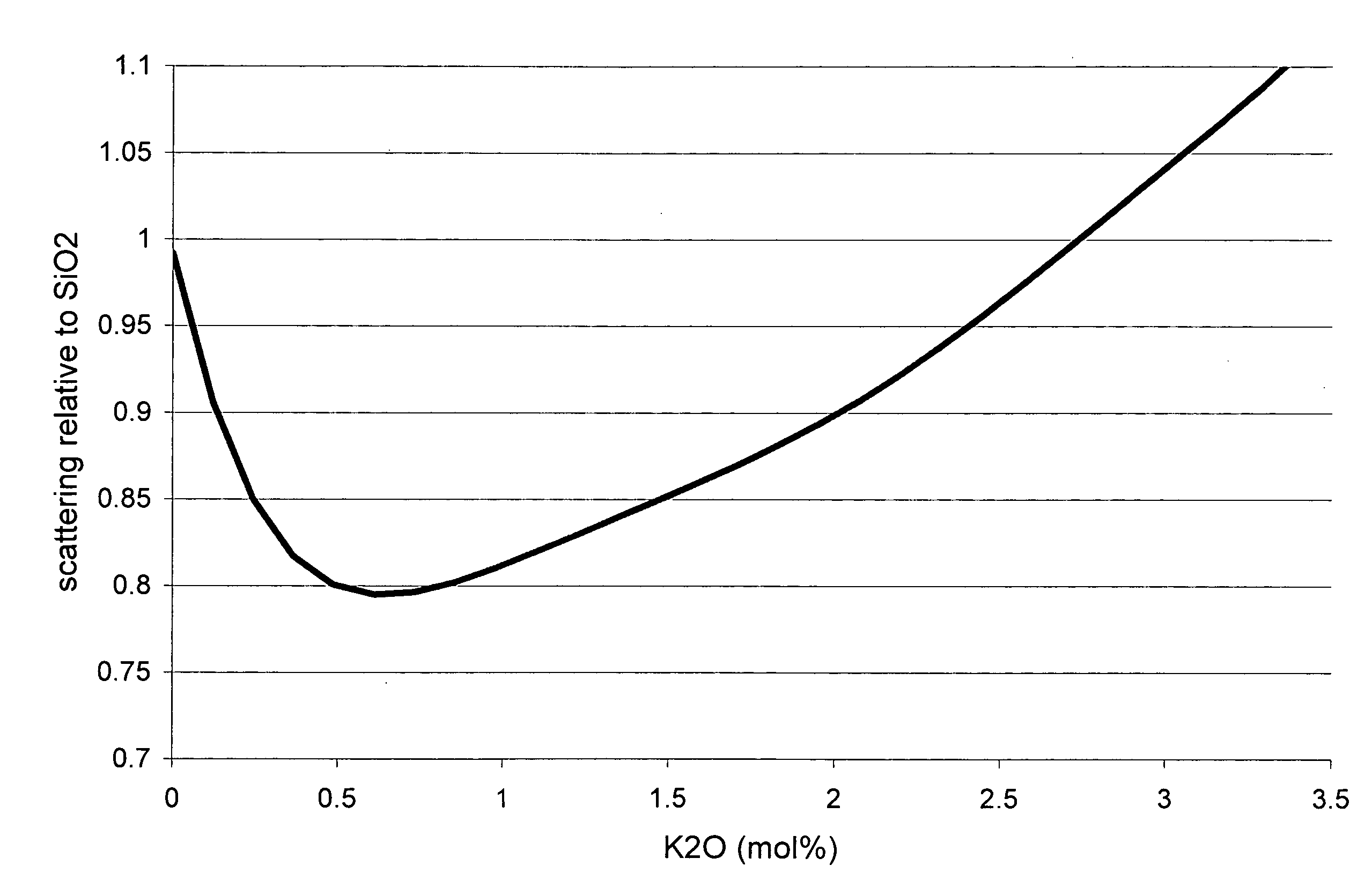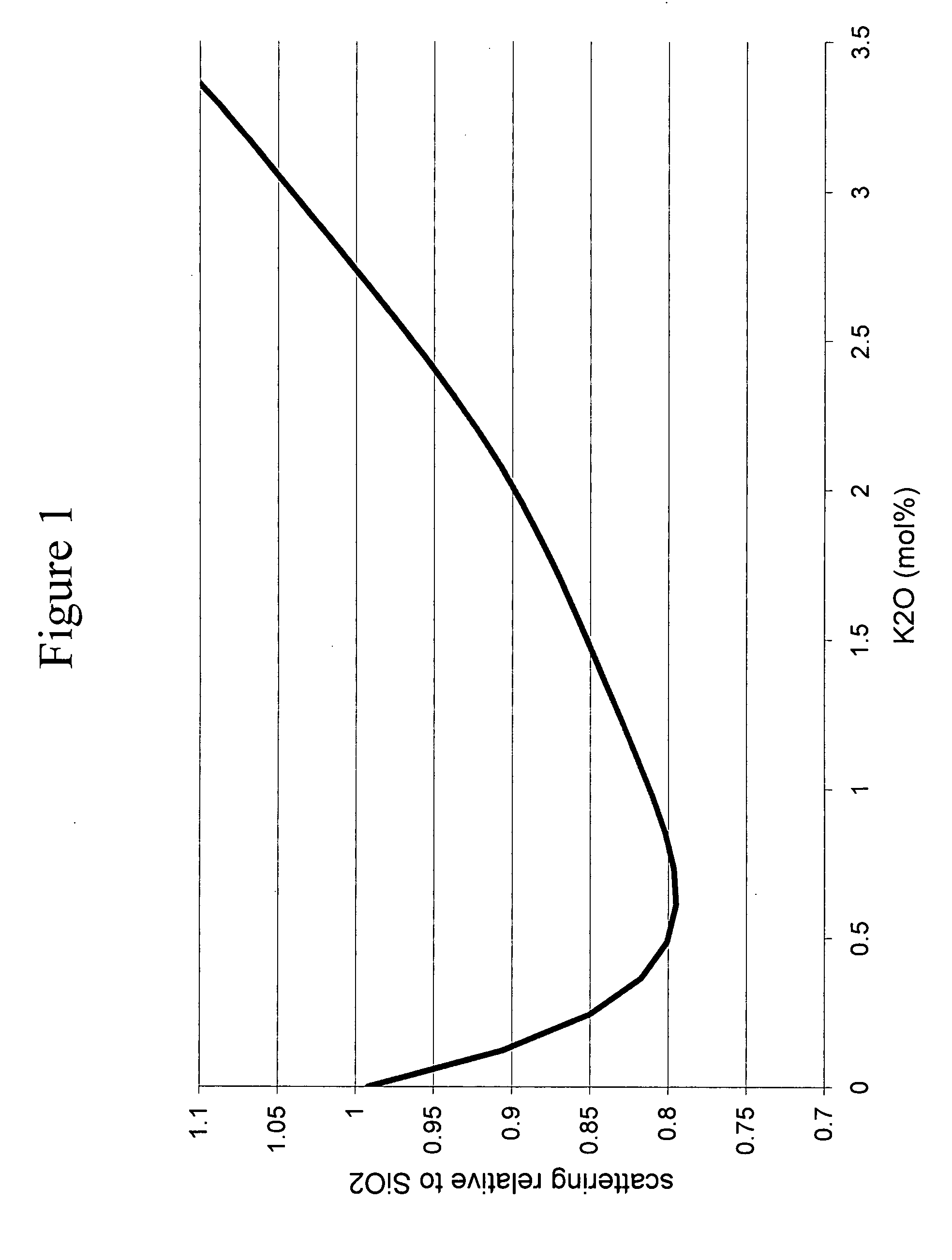Ultra low expansion glass and methods for making
a low-expansion glass and ultra-violet technology, applied in the field of ultra-violet elements, can solve the problems of low expansion titania-silica, inability to economically manufacture mirror elements that can withstand, and difficult radiation manipulation and direction in this wavelength range, so as to reduce the amplitude of striae features, reduce the viscosity of glass, and reduce the amplitude
- Summary
- Abstract
- Description
- Claims
- Application Information
AI Technical Summary
Benefits of technology
Problems solved by technology
Method used
Image
Examples
example 1
[0037]The following example is illustrative of methods that can be used to make a representative composition as described above. Liquid organic precursors of titanium and silicon are combined in a feeder tube to a burner that combusts them together in the presence of oxygen and methane or hydrogen gas to create a fine soot. Suitable precursors are any alkoxides, silanes, and mixed silanes / alkoxides, of which particularly useful examples are octamethylcyclotetrasilane for silicon, and tetraisopropoxy titane (titanium isopropoxide) for titanium. The reactants are mixed in a ratio such that the TiO2 content of the final soot is within the desired range of 5-12 wt %, more preferably 6-8 wt %. The fine soot is collected using readily available technology for accumulating fine particulates, such as a cyclone collector. The soot is suspended in a concentrated solution of ammonium hydroxide to which is added one or more of the hydroxides LiOH, NaOH, KOH, RbOH, or CsOH. The soot loading leve...
example 2
[0041]The following example illustrates a method for diffusing alkalis into a dense TiO2—SiO2 glass to make a new material with lower viscosity and better compositional uniformity. A suitable alkali source is prepared in advance. Suitable sources include refractory brick stable to high temperatures that includes an alkali-bearing grog or binder, or an alkali-bearing TiO2—SiO2 glass prepared by Example 1 or other suitable methods. An alkali-free glass is prepared via conventional CVD methods and a plate is cut with at least dimension suitable for diffusion, preferably about 1 cm thick or thinner. The plate of alkali-free glass is brought into intimate contact with the alkali source along the surfaces perpendicular to the desired diffusion direction, preferably with the alkali source on both sides of the alkali-free glass plate in a “sandwich” configuration. The sandwiched plate and the alkali sources are then heated to high temperature for an extended period of time. A typical temper...
example 3
[0042]A soot precursor of TiO2 and Al2O3 is prepared and 1000 g of it is suspended in 1000 g of 30% ammonium hydroxide via a procedure akin to the first example. Separately, a water soluble salt of aluminum is dissolved in water. Suitable salts include halides and nitrates such as AlCl3.6H2O and Al(NO3)3.9H2O. The salt loading is preferably about 20-50% by weight with respect to water, though lower loading levels will suffice as well. In this example, approximately 24 g of AlCl3.6H2O is dissolved in 50 g of water to make the salt solution. Approximately 30 minutes after the temperature begins to rise, the aluminum salt solution is slowly added to the soot suspension, stirring very vigorously. If clumping occurs initially, a small amount of fresh ammonium hydroxide may be added to re-establish flow. Once the salt solution is dispersed, the soot suspension will begin to thicken, and will gel completely roughly an hour or less. The gel is dried and fired into dense ware via a procedure...
PUM
| Property | Measurement | Unit |
|---|---|---|
| Temperature | aaaaa | aaaaa |
| Fraction | aaaaa | aaaaa |
| Fraction | aaaaa | aaaaa |
Abstract
Description
Claims
Application Information
 Login to View More
Login to View More - R&D
- Intellectual Property
- Life Sciences
- Materials
- Tech Scout
- Unparalleled Data Quality
- Higher Quality Content
- 60% Fewer Hallucinations
Browse by: Latest US Patents, China's latest patents, Technical Efficacy Thesaurus, Application Domain, Technology Topic, Popular Technical Reports.
© 2025 PatSnap. All rights reserved.Legal|Privacy policy|Modern Slavery Act Transparency Statement|Sitemap|About US| Contact US: help@patsnap.com



